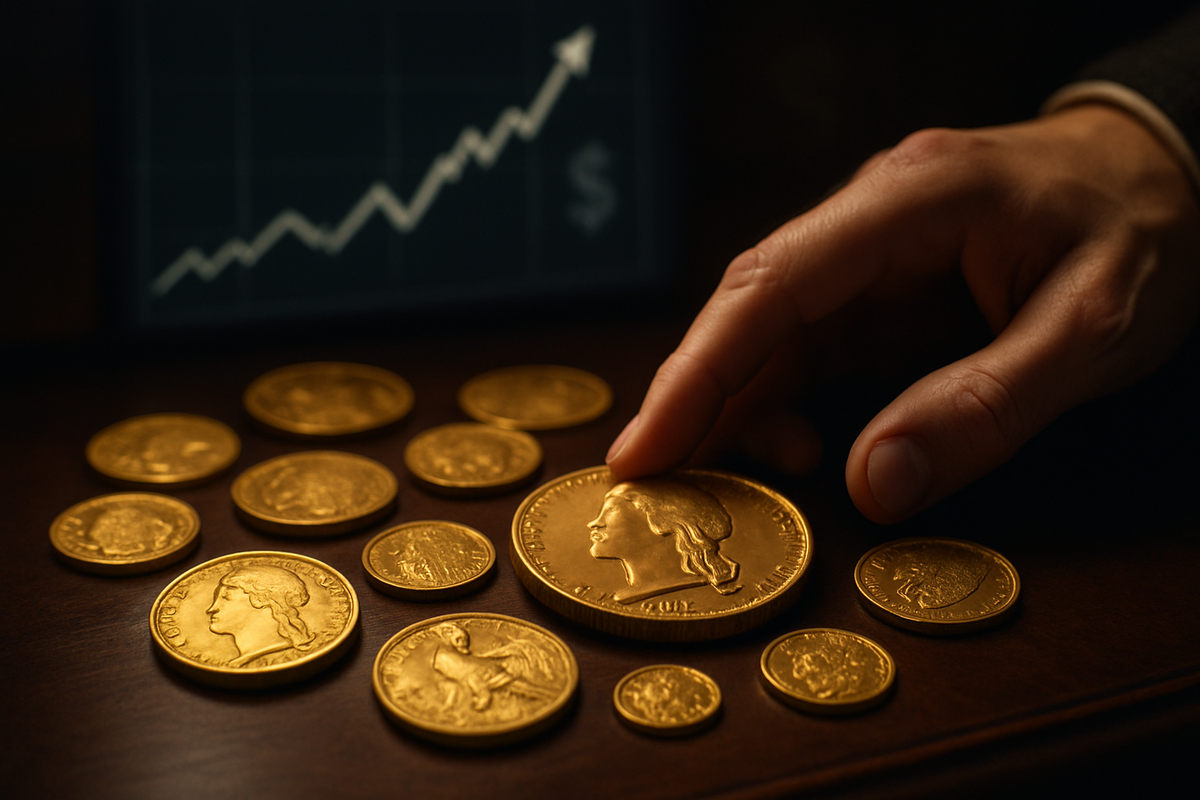Financial News
Gold's Golden Ascent Puts Collectors at a Crossroads: Passion vs. Price in a $4,200/oz Market

The numismatic world is navigating a challenging landscape as gold prices soar to unprecedented heights in mid-October 2025. With spot gold surpassing $4,200 per ounce, a historic milestone, collectors of gold coins find themselves at a critical juncture, balancing their deep-seated passion for collecting with the escalating costs of their cherished hobby. The October 10, 2025, Numismatic News e-Newsletter highlighted this growing caution among collectors, who are increasingly content with past acquisitions and prioritizing intrinsic value over new purchases in a market defined by record-breaking valuations.
This extraordinary surge in gold prices, driven by a confluence of factors including anticipated U.S. interest rate cuts, geopolitical tensions, robust global demand, and persistent inflation fears, has reshaped purchasing strategies across the board. For many, the thrill of the hunt is now tempered by a pragmatic assessment of affordability, leading to a more discerning approach to expanding their collections. The market is witnessing a fascinating interplay between the steadfast dedication of seasoned numismatists and the undeniable financial implications of gold's sustained rally.
Record Gold Prices Reshape Numismatic Strategies
The current gold market, as of October 15, 2025, is characterized by an unprecedented rally, with spot gold reaching an all-time high of $4,217.95 per ounce. This dramatic ascent has been fueled by a potent mix of macroeconomic and geopolitical factors. Expectations of further interest rate cuts by the U.S. Federal Reserve have diminished the appeal of interest-bearing assets, pushing investors towards non-yielding gold. Simultaneously, escalating geopolitical tensions globally have intensified gold's traditional role as a safe-haven asset, drawing significant capital inflows. Strong global demand, particularly from central banks and key markets like India ahead of festive seasons, coupled with persistent inflationary pressures, has further underpinned this bullish sentiment.
The timeline of events leading to this moment has seen gold steadily climb throughout 2025, gaining momentum from early indications of global economic slowdowns and central bank dovishness. By mid-year, concerns over sovereign debt and currency devaluation in various regions solidified gold's appeal. The specific caution among gold coin collectors, as noted in the Numismatic News e-Newsletter on October 10, 2025, reflects the immediate impact of these sustained high prices. Collectors, who typically focus on rarity, historical significance, and aesthetic appeal, are now forced to confront the substantial premium attached to the bullion content of their desired pieces.
Key players in this scenario include individual gold coin collectors, numismatic dealers, and larger precious metals investment firms. Initial market reactions within the numismatic community show a clear split: some long-term collectors are content to hold onto their existing collections, valuing their past acquisitions which have significantly appreciated. Dealers, on the other hand, are approaching new inventory acquisitions with heightened caution, wary of potential downside risks if prices correct. There's also a noticeable "fear of missing out" (FOMO) among some investors, who, despite the high prices, are rushing to secure gold positions, anticipating further increases. This dynamic underscores a broader shift where traditional collecting interest is increasingly intertwined with investment motives.
Industry Players Navigate a Shifting Gold Landscape
The soaring gold prices present a mixed bag for public companies operating within the precious metals and numismatic sectors. Gold mining companies stand to be significant beneficiaries. Firms like Barrick Gold Corp. (NYSE: GOLD) and Newmont Corporation (NYSE: NEM) are likely seeing substantial increases in their revenue and profit margins, assuming their production costs remain relatively stable. Higher gold prices directly translate to greater profitability per ounce extracted, potentially leading to increased capital for exploration, debt reduction, or shareholder returns. However, they also face the challenge of rising operational costs, including labor and energy, which could temper some of these gains.
Conversely, companies heavily reliant on new consumer purchases of gold coins or small bullion products might experience a deceleration in sales volume, even if the value per transaction increases. While some investors are driven by FOMO, the average collector, as highlighted by the Numismatic News, is becoming more cautious. Companies like APMEX (a prominent online retailer of precious metals) or even traditional mints that sell directly to the public could see a decline in the number of units sold, especially for common bullion coins where the premium over spot price becomes a significant deterrent. Their winning strategy might pivot to focusing on rare, numismatic-grade coins where the intrinsic collector value outweighs the bullion price, or by offering more affordable fractional gold products.
Luxury goods retailers, particularly those specializing in high-end gold jewelry, such as Tiffany & Co. (NYSE: TIF) or Richemont (SWX: CFR) which owns Cartier, might also face challenges. While gold's rising value enhances the perceived prestige of their products, the direct cost to consumers increases significantly. This could lead to a shift in consumer preferences towards smaller gold items, lower caratage, or alternative luxury materials, impacting sales volumes in their gold-heavy collections. On the other hand, the increased wealth of those holding gold might translate into higher demand for other luxury items, creating an indirect benefit. Overall, companies that can adapt their product offerings and marketing strategies to address the price sensitivity of collectors and consumers will be best positioned to navigate this high-price environment.
Broader Implications: Gold's Role in a Volatile Economy
The current surge in gold prices and the cautious stance of collectors are not isolated events but rather fit into broader industry trends shaped by global economic uncertainty and inflationary pressures. Gold's rally reflects a growing lack of confidence in traditional financial assets and fiat currencies, a trend exacerbated by the significant monetary easing policies implemented by central banks worldwide in recent years. This phenomenon is further amplified by geopolitical instability, pushing investors and even central banks to increase their gold reserves as a hedge against unforeseen crises. The current situation echoes historical precedents where gold has served as a safe haven during times of economic turmoil or political unrest, such as the oil crises of the 1970s or the financial crisis of 2008.
The ripple effects of this event extend beyond the immediate numismatic and precious metals markets. Competitors in the investment landscape, particularly those offering alternative inflation hedges like real estate or certain commodities, might see increased interest as investors diversify their portfolios beyond just gold. Partners in the supply chain, from refiners to secure logistics providers, are likely experiencing heightened activity, though they also face the challenge of securing and transporting increasingly valuable physical assets. Regulatory bodies might also pay closer attention to the gold market, potentially scrutinizing trading practices or considering measures to enhance market transparency, especially if price volatility becomes extreme.
This situation also highlights a shift in the perception of gold from purely an industrial or luxury commodity to an essential strategic asset for wealth preservation. The active accumulation of gold by central banks globally, which has been a consistent trend in recent years, lends significant credibility to gold's role as a store of value and a hedge against currency debasement. This institutional buying provides a strong floor for gold prices and influences investor sentiment, reinforcing the idea that gold is a critical component of a diversified portfolio in an unpredictable global economy. For collectors, this means their hobby is increasingly intertwined with broader financial markets, making the "collector vs. investor" dilemma more pronounced than ever.
What Comes Next: Navigating the Golden Horizon
Looking ahead, the trajectory of gold prices and collector behavior will largely depend on the evolution of global economic conditions, central bank policies, and geopolitical stability. In the short term, if inflation persists and central banks, particularly the U.S. Federal Reserve, signal further interest rate cuts, gold prices could continue their upward momentum. This would likely solidify the cautious approach among gold coin collectors, potentially leading to a market where high-value, rare numismatic items still command interest, but common bullion-related coin purchases remain subdued. Dealers might focus more on consignment sales or facilitating transactions for sellers looking to capitalize on high prices.
In the long term, several scenarios could unfold. If global economies stabilize and inflation is brought under control, leading to a period of sustained economic growth and rising real yields, gold prices could experience a correction. Such a scenario might reinvigorate the broader gold coin collecting market, making it more accessible for enthusiasts to expand their collections without the overwhelming influence of bullion value. Conversely, a deepening of geopolitical conflicts or a severe global recession could propel gold even higher, further transforming the numismatic market into a more investment-driven arena.
Potential strategic pivots for market participants include numismatic dealers offering more flexible financing options for high-value purchases or diversifying into other collectible assets that are less sensitive to commodity price fluctuations. Mints and coin producers might focus on innovative designs or limited-edition releases that emphasize artistic and historical value over sheer gold content to attract collectors. Market opportunities may emerge in fractional gold products or in services that help collectors manage and authenticate their existing high-value gold holdings. The challenges will primarily revolve around managing price volatility and adapting to a collector base that is increasingly price-sensitive and investment-aware. Investors should watch for central bank announcements, inflation data, and geopolitical developments, as these will be key indicators of gold's future direction and, consequently, the health of the gold coin collecting market.
A Golden Reflection: Balancing Passion and Prudence
The current landscape for gold coin collectors is one of profound transformation, driven by gold's unprecedented surge past $4,200 per ounce in mid-October 2025. The core takeaway is a palpable shift in collector sentiment, moving from unbridled acquisition to a more discerning and cautious approach, as highlighted by the Numismatic News e-Newsletter. Collectors are increasingly content with their past buys, recognizing the significant appreciation in value, and are now keenly balancing their passion for numismatics with the pragmatic realities of rising costs. This has created a bifurcated market where investment motives are increasingly intertwining with traditional collecting interests.
Moving forward, the gold market is poised to remain a critical indicator of global economic health and geopolitical stability. The sustained rally underscores gold's enduring role as a safe-haven asset and a hedge against inflation and currency debasement. For public companies involved in gold mining, this period represents significant profitability, while those in the numismatic and luxury goods sectors must adapt their strategies to cater to a more price-sensitive and investment-conscious consumer base. The broader significance lies in how this event reflects deeper macroeconomic trends and historical patterns of gold's performance during times of uncertainty.
Investors should closely monitor central bank policies, particularly interest rate decisions, and global inflation figures, as these will be primary drivers of gold's short-to-medium-term trajectory. Geopolitical developments will also continue to play a crucial role in shaping safe-haven demand. For collectors, the coming months will be about strategic patience, careful evaluation of new acquisitions, and perhaps a renewed appreciation for the intrinsic historical and artistic value of their existing collections. The golden age of collecting is now inextricably linked to the golden age of investment, demanding both passion and prudence from all market participants.
This content is intended for informational purposes only and is not financial advice
More News
View More




Quotes delayed at least 20 minutes.
By accessing this page, you agree to the following
Privacy Policy and Terms Of Service.




